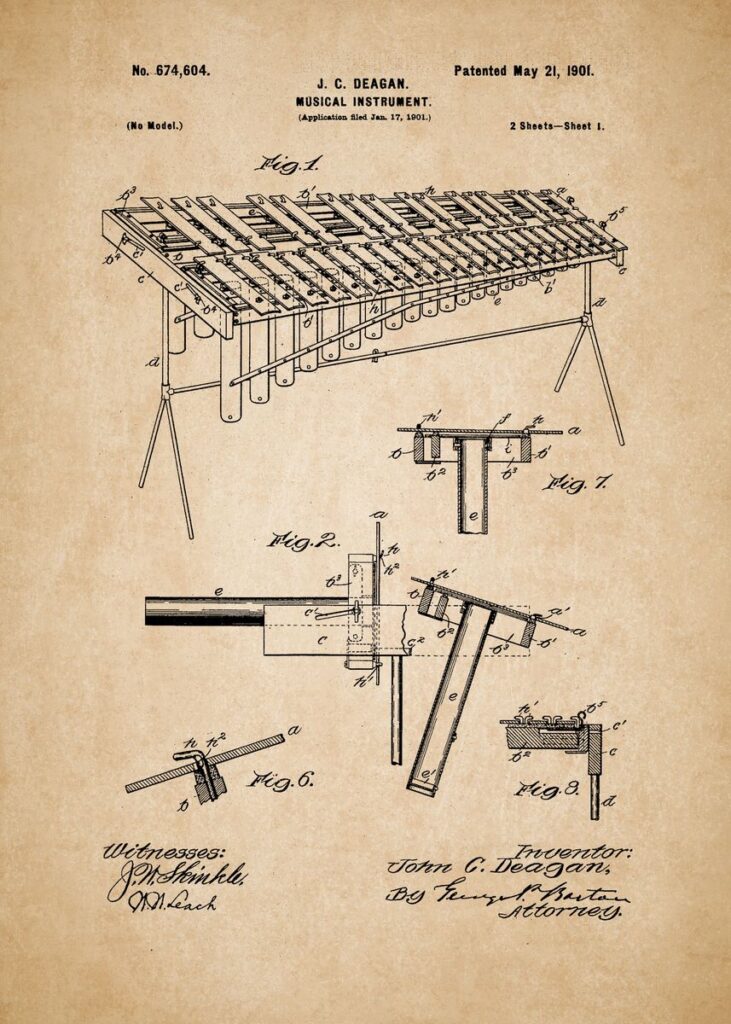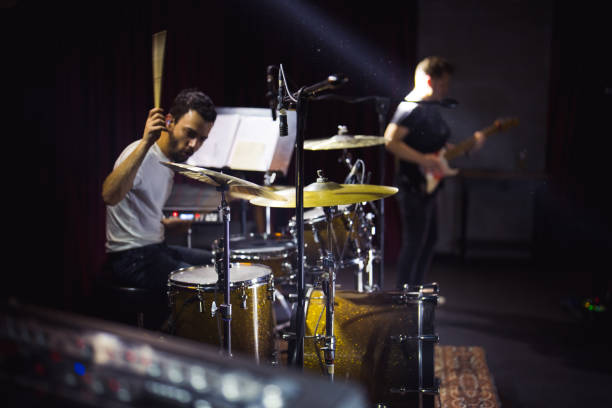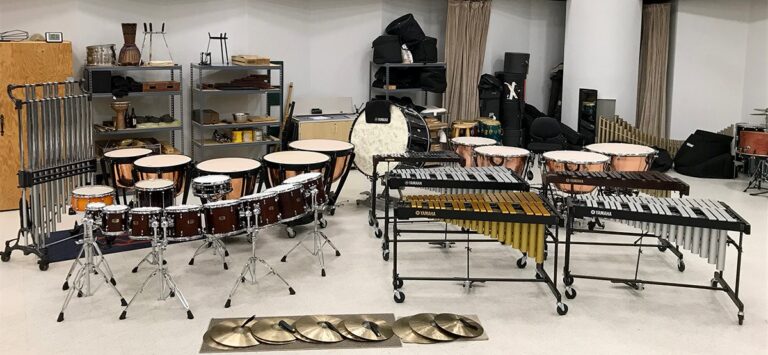Introduction
The xylophone is a percussion instrument consisting a series of wooden bars which are struck with mallets to produce sound. Traditionally, these bars are made rosewood, padauk, or synthetic materials known for their excellent resonance and tonal quality. The xylophone’s bright timbre allows it to stand out in an orchestral setting, often adding a crisp and clear layer of sound to the symphony. Its role in symphony orchestras can vary, from providing rhythmic support to enhancing melodic lines with its distinct, percussive accent. The versatility and unique sound of the xylophone make it an invaluable asset to the overall orchestral palette.
Definition
The term “xylophone” refers specifically to the derived Greek words “xylon,” meaning wood, and “phone,” meaning voice or sound.
Percussion Family
The xylophone is a quintessential example of a pitched percussion instrument within the wider percussion family. Unlike unpitched percussion instruments that produce sounds of indefinite pitch, such as the snare drum or cymbals, the xylophone resonates at specific pitches, allowing it to play melodies and harmonies. Playing the xylophone is just one aspect of a percussionist’s responsibilities; they are skilled in managing an array of instruments from timpani and marimbas to tambourines and triangles.
Historical Context

Origins and Evolution
The first true xylophones appeared in the 9th century in southeast Asia. This proto xylophone essentially consists of a few wooden bars struck with sticks or padded mallets. These early Asian instruments paved the way for the xylophone’s evolution and adaptation across different cultures. In these regions, xylophones were often used in religious ceremonies and traditional music, demonstrating their cultural significance and versatility.
Simultaneously, xylophones were also being developed in Africa, where they featured a unique design with gourd resonators. These African xylophones, known as balafons, utilize hollowed-out gourds affixed underneath the wooden bars to amplify their sound. Natural materials like gourds were used as resonators to extend the resonance of the bars. This design creates a more warm and resonant sound. The diverse construction techniques and materials used across continents highlight the xylophone’s universal appeal and adaptability throughout history.
Introduction to the Symphony Orchestra
The xylophone’s first notable appearance in a symphony orchestra was in Camille Saint-Saëns’ “Danse Macabre” in 1874. In this composition, the xylophone’s sharp, staccato notes vividly evoke the imagery of bones clattering and skeletons raucously dancing in the midnight darkness. Saint-Saëns cleverly utilizes the xylophone to mimic the brittle, bone-like sound one might imagine from skeletons engaging in a macabre dance. The xylophone’s ability to produce rapid, percussive strikes adds a sense of urgency and eeriness to the music, making the spectral dance come to life for the listener.
The early 20th century saw a significant expansion of the western xylophone’s role in symphonic music. Composers like Igor Stravinsky and Claude Debussy embraced the chromatic instrument, integrating it into their works and elevating its status as a serious orchestral instrument. This period marked the beginning of the xylophone’s acceptance and prominence in symphonic compositions.

Key Compositions
“Rhapsody in Blue” by George Gershwin (1924)
In George Gershwin’s iconic “Rhapsody in Blue,” the xylophone plays a crucial role in adding rhythmic drive and color to the piece. Its bright and lively tones complement the jazz-inspired themes and contribute to the composition’s energetic and vibrant atmosphere.
“Boléro” by Maurice Ravel (1928)
Maurice Ravel’s “Boléro” is renowned for its hypnotic and repetitive melody, which gradually builds in intensity. The xylophone’s precise and rhythmic playing adds a unique texture to the piece, enhancing its mesmerizing quality and contributing to the overall crescendo.
“The Planets” by Gustav Holst (1916)
Gustav Holst’s suite “The Planets” features the xylophone prominently, particularly in the movement “Mars, the Bringer of War.” The musical instrument’s sharp and aggressive tones underscore the martial theme, creating a sense of urgency and power that is central to the composition’s character.
“The Golden Age” by Dmitri Shostakovich (1930)
In Dmitri Shostakovich’s ballet “The Golden Age,” the xylophone plays an instrumental role in conveying the vibrant and satirical essence of the music. Written during a period of great artistic experimentation, “The Golden Age” blends traditional Russian music with jazz and contemporary dance, creating a unique soundscape. The xylophone stands out with its bright, articulate timbres, enhancing the ballet’s dynamic and playful sections.
Tuning Systems and Adaptation to Western Music

The tuning systems of Southeast Asian and African xylophones reflect the distinct musical traditions and tonal frameworks of these regions. Southeast Asian xylophones often follow a pentatonic scale, a five-note musical scale commonly found in traditional music from this area. The specific intervals between the notes in this scale differ from those of the Western music scale, giving Southeast Asian xylophones a unique and characteristic sound.
In contrast, African xylophones like the balafon typically use a heptatonic scale, which has seven notes. However, these notes do not correspond directly to the Western equal temperament tuning system. The intervals may vary, creating a range of tonalities that are deeply ingrained in the cultural music practices of various African communities. Each balafon is finely tuned by the artisans that create them to fit the specific musical needs of their tradition.
When the xylophone was adapted for Western music, it underwent significant modifications to align with the 12-tone equal temperament system, which is the standard in Western classical music. This tuning system ensures that the xylophone can integrate seamlessly with other Western orchestral instruments, similar to the keys of a piano. Each bar on the Western xylophone is meticulously crafted to produce accurate pitches corresponding to the chromatic scale, allowing for complex harmonies and melodic lines.
The reconfiguration of the xylophone to fit the Western scale involved not just retuning, but also adjusting the size and placement of the bars. Most modern xylophones are arranged to have 3.5 or 4 octaves of range. This adaptation was essential for the xylophone to be incorporated into the rich tapestry of symphonic music, enabling it to contribute to a wide variety of compositions and styles within the Western classical tradition.
Technical Aspects of Playing the Xylophone in a Symphony
Mallets and Tonal Quality
Selecting the appropriate mallets is essential for achieving the desired tonal qualities and dynamics. Softer mallets produce a warm, mellow sound, while harder mallets yield a bright, piercing tone. Players must choose mallets based on the musical context and the specific requirements of the piece.
Striking Technique
Proper mallet striking technique is crucial for clarity and resonance. Players must strike the all the bars precisely and consistently to produce a clean and articulate sound. Mastery of this technique allows for expressive and nuanced performances.
Hand Positioning and Accuracy
Accurate and consistent play across the xylophone’s range requires careful hand positioning. Players must develop dexterity and control to navigate the instrument’s layout effectively. Attention to hand placement ensures precise note execution and smooth transitions between pitches.
Coordination and Timing
Effective coordination with the orchestra is essential for cohesive performances. Xylophonists must recognize cues from the conductor and fellow musicians, executing their integral part with precise timing. This synchronization enhances the overall musicality and unity of the performance.
Managing Physical Demands
Playing the xylophone in a symphony requires physical endurance and control. The instrument demands repetitive and often rapid movements, which can be physically taxing. Developing stamina and employing proper techniques help players manage the physical demands and maintain consistent performance quality.
Xylophone in Music Education

Carl Orff and the Xylophone in Early Music Education
Carl Orff, a German composer and music educator, revolutionized music education with his innovative teaching approach known as the Orff method. This method emphasizes the importance of integrating music, movement, speech, and play in a creative learning process. Central to Orff’s philosophy is the use of simple, percussive instruments, with the xylophone playing a significant role.
In early music education, xylophones are particularly valued for their accessibility and ease of use. Even young children can produce pleasing tones without the need for advanced techniques. The instrument’s straightforward layout and visual representation of pitch help students grasp fundamental musical concepts, such as melody, harmony, and rhythm. By engaging in hands-on exploration and improvisation with xylophones, children develop a strong foundation in musical literacy and creative expression.
The prominence of the xylophone in Western culture can, in part, be attributed to the widespread adoption of the Orff Approach in schools and educational programs. The xylophone’s effectiveness in teaching basic musical skills and fostering a love for music ensures its continued presence in music classrooms. This early exposure often leads to a lifelong appreciation of the xylophone and its unique sound, cementing its place in both educational and professional musical landscapes.
Conclusion
The xylophone’s journey spans continents and cultures. From Southeast Asia to Africa, its unique sounds are cherished. Western adaptations have made it integral to classical music. The xylophone excels in music education, thanks to the Orff Approach. This instrument’s role in both learning and professional music is undeniable. Its rich history and versatility ensure the xylophone’s continued relevance.




